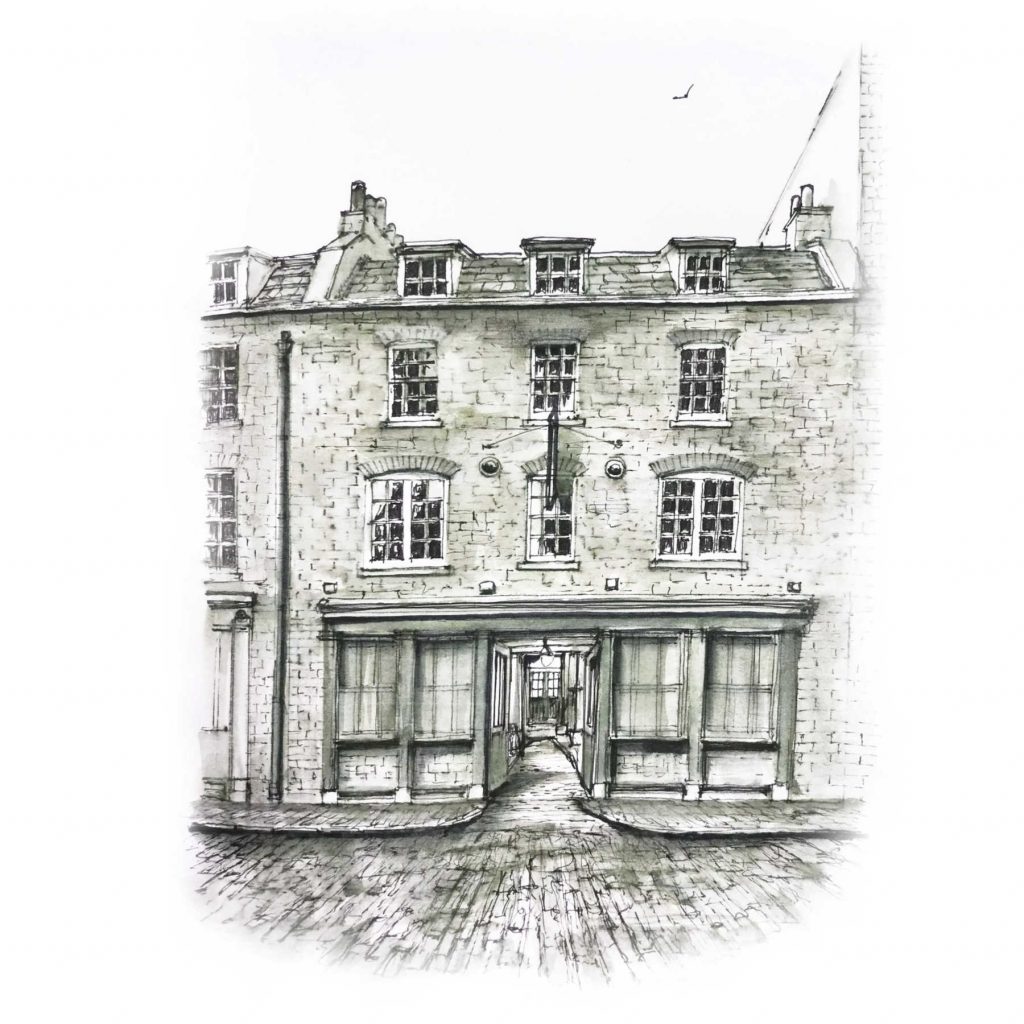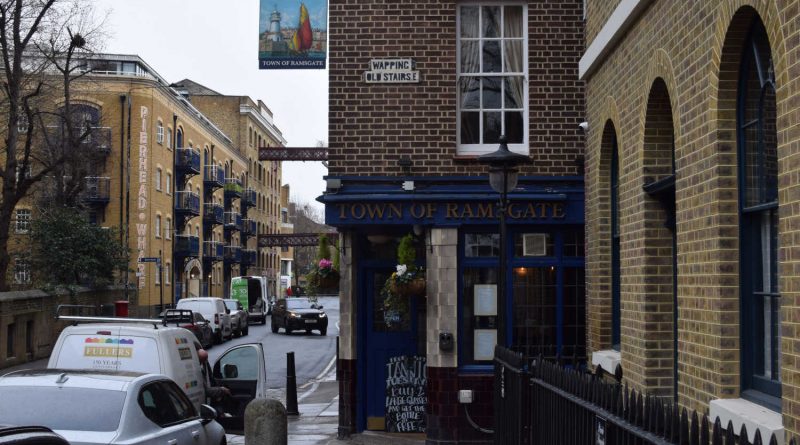From Town of Ramsgate to Prospect of Whitby, a walk between Wapping’s oldest pubs
Wapping’s quiet riverside location is home to some of the East End’s most historic pubs, ideal for a view of the Thames, a quiet pint, and a portion of mushy peas.
We’re all tucked away in the corner of the Town of Ramsgate, a sixteenth-century pub at the beginning of this walk up Wapping High Street. It feels cosy and traditional, with tartan carpets, wooden wall trimmings, and wall-hanging lanterns giving off a warm light.
An artist points to a painting on the wall; it’s a view of a bend in the Thames and a wonky pub with large windows crouching on the opposite bank, a scene that can be seen from the back garden of the pub. Beside him, two men stare at the painting, slinging coats and bags over their shoulders. He gives the two men his business card.
I leave out of the fire door into a narrow passage leading to a small riverbank beach where the milky brown Thames is lapping against the shore.
There’s the view again. Squinting, you can just about make out the Angel pub on the opposite bank, in Bermondsey.
I made the short cycle from Whitechapel to Wapping to visit and walk between the Town of Ramsgate and the Prospect of Whitby, each with a claim to be the oldest riverside pub in the borough, and perhaps all of London.
Opposite the pub, on the roadside now, is a decorative front garden with flowers and gnomes. Everything is calm, and the street is strikingly quiet compared to the rest of Tower Hamlets.
The Town of Ramsgate forms part of a delightful square around St John’s Churchyard, with the green-tiled Turk’s Head pub in the northeast corner, and the London baroque St John the Evangelist Church and Old School on the east side.
In Geoffrey Fletcher’s 1963 book City Sights, he recommends visiting the square to ‘inhale the river air, scented with the spices of the great grim warehouses’. There’s no smell of spices today – the warehouses have since been converted into houses and shops – but the freshness of the river air still looms.
Architecturally the warehouses offer an appealing juxtaposition to Wapping’s village feel. Further up Wapping High Street, you crane your neck to look up at two steel red footbridges linking the warehouses on each side. It’s like being transported from Beatrix Potter to Blade Runner.
Il Toscano, an Italian restaurant for white-cloth dining, marks the southwest corner of Wapping Rose Gardens, an expansive green space dotted with low-hanging trees.
Magpies are chattering, pigeons are cooing, and a squirrel opens a nut on the ground. The clouds have drawn back to reveal a blue sky and golden light reflects off the windows of a converted soap factory as you look up.
Crossing back over the street as you leave the park is a low cobbled alleyway leading to the Captain Kidd pub, named after the pirate who was executed on a riverside Wapping beach nearby.

Inside, three men with broad East End accents are reminiscing at the bar, ‘Remember Johnny? He had a memory like an Encyclopedia!’ As I order a pint of ale and a portion of chili crackers, their conversation drifts from women of the past (‘I’ll never see her again!’) to police encounters (‘dodgy coppers’).
I take an alcove seat overlooking the Thames. With the sun shimmering off the river, birds swooping overhead, and a pint of ale in front of me, it feels like I’m sitting down to write my life story.
As I leave I step out into a purple dusk light that reminds me to pick up the pace so that I can arrive at the Prospect of Whitby by dinner. I walk under a shaded colonnade up Wapping High Street that feels like Bologna if it had been built in Britain in the 1970s.
I pass the Wapping Overground station and arrive at New Crane Place, where a narrow alley takes me to New Crane Stairs, which leads down to a stretch of beach.
Stepping out onto the beach, gritty sand crunches underfoot. In the distance, the skyscrapers of Canary Wharf appear as if they are carrying the orange moon on their shoulders. The quiet crashing of the river competes with the hum of people chatting on their balconies above.
I follow Wapping High Street as it bends around New Crane Place and straightens out again. There, at the end of the street, is the Prospect of Whitby. Its lanterns gingerly light up the pavement outside.
As I get closer, each time the door is opened, I can briefly hear the mutter of a jovial crowd inside. Being evening now, the pub is full of people in smart clothes who must have come from work, some queuing at the bar, some hunched around tables drinking and chatting.
There is a strong vinegar smell and everyone seems to be sharing a steaming hot plate of chips with someone. My £17 plate of fish and chips is crispy, salty, and warm, dipped into ketchup and mushy peas.
The inside of the pub is like a ship itself, with 400-year-old stone flooring, a low ceiling, an ornate bar, wooden wall trimmings and stairs, and wall lanterns giving off a soft orange light.
Dating back to 1520, the pub has had its fair share of divisive visitors, from seafarers like Sir Hugh Willoughby, who set sail from here to China in 1553, to land-dwellers like Judge Jeffreys, who had a reputation for hanging anti-Royalists in the seventeenth century.
Today, with punters packed around the bar, rubbing shoulders and chatting, divisions between city workers, family groups, and small gatherings of twenty-somethings all seem to melt into one happy hive of activity.
Taking a sip from my pint of ale, I reflect on the quiet cosiness of this portion of Wapping. Stacked with so many warehouses, and with the major economic force of the Thames on its doorstep, it’s strange to think of how industrial Wapping once was.
There’s an element of sadness to think that all of this energy has now gone, converted into shuttered, luxury apartments. But what remains of Wapping is stunning riverside views, and the excitement that around almost every corner is a friendly pub and a story of piracy, trade, or industry.
If you enjoyed this, you may like reading about pub signs of Whitechapel.

